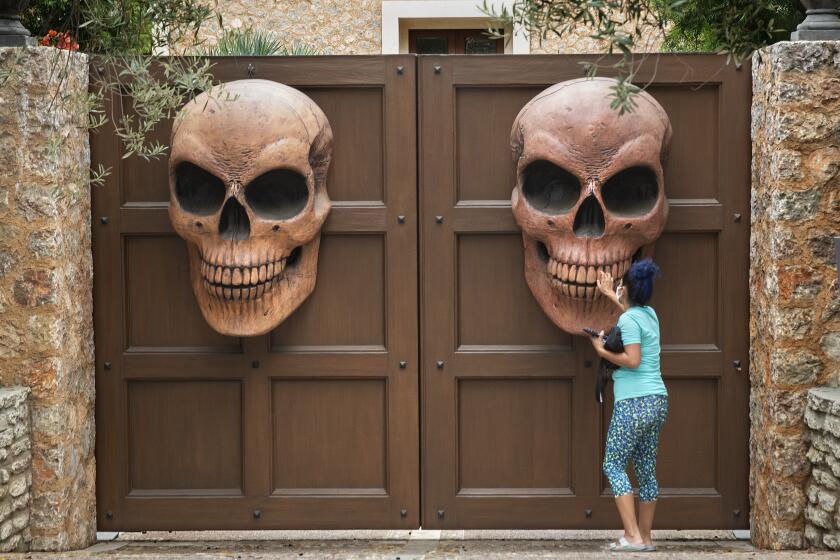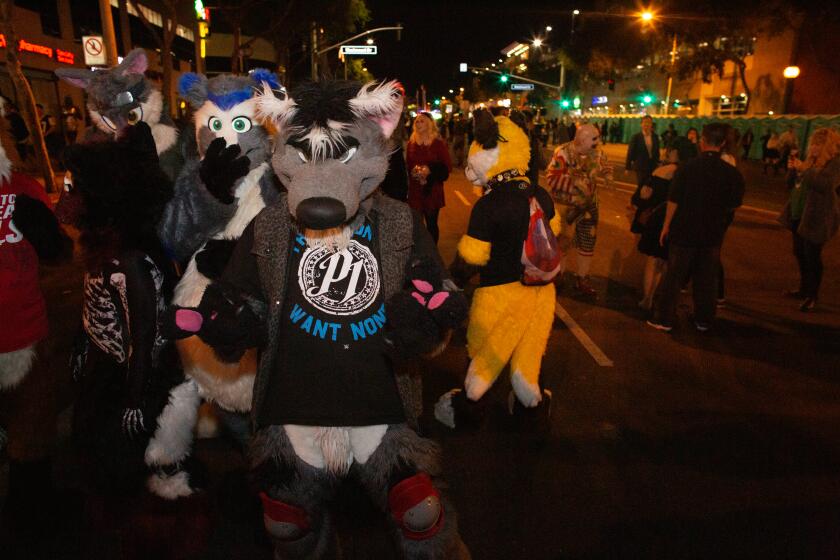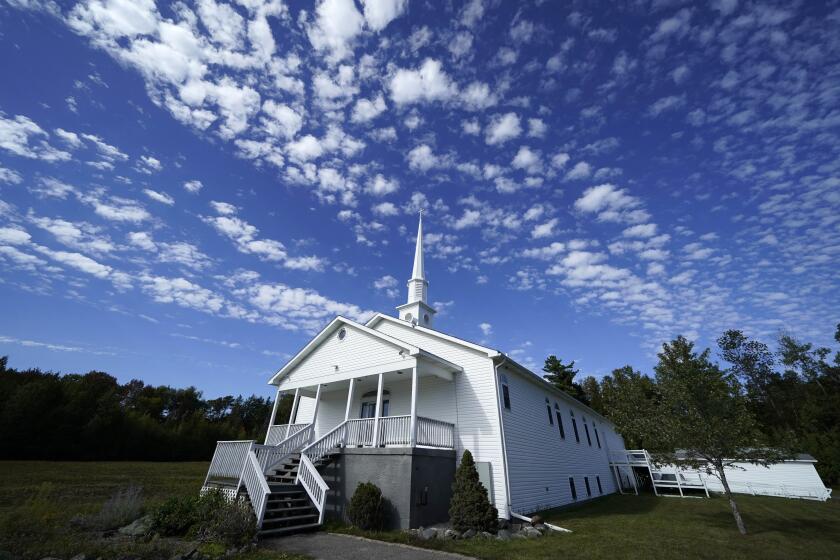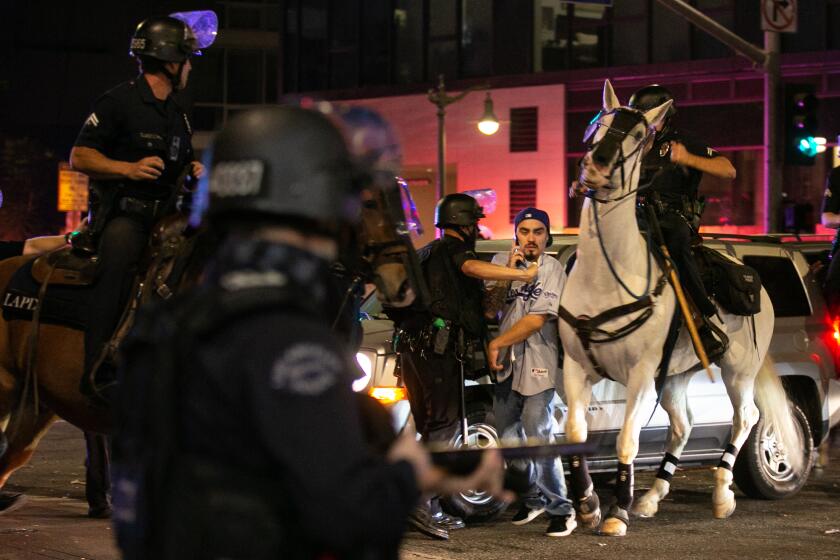Halloween a do-or-die moment in California fight against fall COVID-19 wave
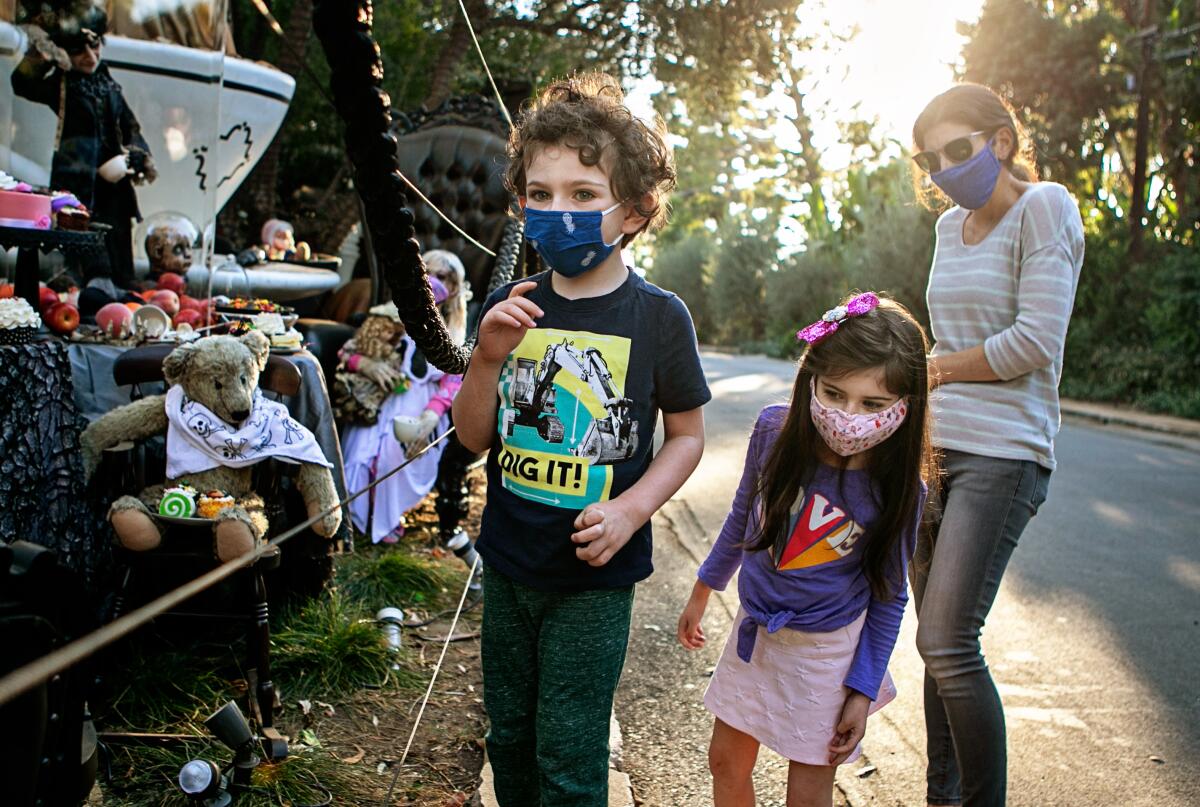
Halloween is the one day of the year where being scared isn’t only accepted, it’s encouraged.
But with worrying signs of a potential coronavirus rebound in California and cases surging to unprecedented heights in other parts of the U.S., government officials and health experts say this year’s fright night carries a very real threat.
State officials have been driving home the message that, with the virus still widespread, Californians shouldn’t celebrate the holiday like normal.
Trick-or-treating is strongly discouraged and, in some places, banned. Major events, such as West Hollywood’s Halloween Carnaval and the Queen Mary’s Dark Harbor haunt in Long Beach, have been scrapped.
“Treat yourself and your family to a safe Halloween. Don’t trick the community to even higher levels of spread,” said Dr. Robert Kim-Farley, medical epidemiologist and infectious disease expert at the UCLA Fielding School of Public Health.
Eight months into the pandemic, Halloween is looking different this year. Decorations and celebrations across the Southland keep the spirit alive.
Though not as bad as the rest of the nation, there are signs the pandemic is worsening in California. More than 30,200 coronavirus cases were reported for the seven-day period that ended Thursday, a 19% jump from the previous week, a Los Angeles Times analysis found. Hospitalizations have risen for two consecutive weeks.
Californians also are increasingly testing positive. The rate at which coronavirus tests are coming back positive for the seven-day period that ended Thursday was 3.33%; at the beginning of the month, it was 2.42%.
Even San Francisco — California’s only urban county in the state’s least restrictive reopening tier — is reporting increasing hospitalizations and positive test rates.
The city announced a pause in its reopening plans Friday, with Mayor London Breed saying, “COVID-19 is not tired of us just because we’re tired of it.”
For Halloween, the real danger is that the decisions residents make — whether to head to this sizable shindig or that hush-hush haunted house — will have ripple effects long afterward, experts say.
“It’s not just about who might get infected on Halloween as a result of an ill-advised party, but it’s the line of people I see standing behind that person who are going to get infected as a result,” said Paula Cannon, a professor of molecular microbiology and immunology at the Keck School of Medicine at USC. “And, frankly, some of the people in that line are ghosts.”
The stakes are high. California let its collective guard down around Memorial Day, and for weeks paid the price as infections, hospitalizations and deaths surged, making the summer the state’s deadliest COVID-19 season.
L.A. city and county officials are asking residents to be creative in their Halloween celebrations and to avoid trick-or-treating.
Though the state has made significant progress since then — through a mandatory mask order, business restrictions and continued public vigilance — Halloween is the harbinger of the wider holiday season. Many experts have predicted that a new coronavirus wave could crest as colder temperatures push people inside and families and friends gather to celebrate.
“The reality is 24 states over the last seven days ... have experienced record-high cases of COVID-19,” Gov. Gavin Newsom said Friday. “We’re entering into the holiday season, where people are more likely to mix; we’re entering into the winter months, when more people are more likely to come back indoors; we’re entering into the flu season, which will put compounding and competing challenges in our healthcare delivery system.”
L.A. County’s public health director explains how family celebrations and other gatherings could turn into potentially deadly coronavirus outbreaks.
Los Angeles County is already starting to see a notable uptick in its daily number of new coronavirus cases — from about 940 at the beginning of October to nearly 1,200 as of last week.
“We still have way too much community transmission happening, and it won’t help us as we head into the colder months, as we head into flu season, with what’s in front of us if we can’t, right now, start moving in a different direction,” county Public Health Director Barbara Ferrer said.
The county reported 1,745 new COVID-19 cases Thursday, the highest one-day increase not connected to a reporting backlog since August. There have been 10,987 reported cases in the seven-day period that ended Thursday, a 39% increase from the previous week.
“What worries me is that it’s going up,” Ferrer said about the county’s case rate. “And even if the increase is relatively small, we have seen before that, without a lot of attention, we can accelerate to a place where it actually creates the possibility of overwhelming the healthcare system and, certainly, causes a lot of illness and death.”
The rise in cases and positive test rates means it’s not the time to attend large Halloween get-togethers or gather to watch election night results, experts say. Nor is it advisable to rent hotel rooms for a birthday bash, as some younger adults are doing.
“This is not the time to go out and have some wild party,” said Dr. George Rutherford, an epidemiologist and infectious diseases expert at UC San Francisco.
The state has generally banned large gatherings, and says smaller ones of no more than three households may be held outdoors with limitations, including time limits and social distancing.
“This is not the time to be taking your masks off. This is not the time to be going inside and not maintaining social distance,” Rutherford said. “This is not the time to be out messing around.”
Part of being able to reopen society is needing to pause when disease levels worsen to a worrying degree.
“This virus takes off very quickly. So we want to be able to stay ahead of the virus. By the time you have lots of cases and try to catch up, the healthcare systems are often overwhelmed. And that’s where you see more devastation from this virus,” said Dr. Grant Colfax, director of public health for San Francisco.
Officials announced the highest one-day increase in cases not connected to a reporting backlog since August.
It’s important to keep in mind that rising case rates “represent new people that have the potential to go and infect other people,” Cannon said.
“You’re setting the seeds of new infections in new families, in new workplaces and in new homes,” she said. “That’s the danger of this virus ... we are just creating a sort of unsustainable situation where this will just keep going and going and going.”
While infection risks are inherent with any gathering, Halloween is especially troubling because parties and trick-or-treating “involve face-to-face interactions with people from different households,” said Dr. Wilma Wooten, San Diego County’s public health officer.
“If a COVID-19 infection is detected among a participant, it will be very difficult to find and notify those who may have been exposed,” she said in a statement.
It can take days for those infected to show symptoms, if they ever do. Yet those without symptoms can still be vectors for the virus. And it can take weeks for someone to fall ill enough to require hospitalization.
That’s what makes the conga line of late-in-the-year holidays so troubling from a public health perspective.
“We do not want to see one event foster increased transmission that is then amplified in the next event, then further amplified in the next event,” Kim-Farley said.
‘Los Angeles Haunted Hayride,’ drive-in movies, drive-thru scares, ‘Night of the Living Dead Live!’ and more.
While Halloween may be abnormal this year, that doesn’t mean residents can’t scare up some fun in a safer way.
Families can go to drive-through trick-or-treat events or car parades, hold online parties or just put on their costumes to walk around for a bit.
“Little kids holding the hands of their parents in their Capt. America costume, you can do that quite safely,” Cannon said. “As a parent, you can take your child or your children out early to walk around, maybe in less crowded areas of your neighborhood. You can have candy with you and reward the kids ... make it sort of a Halloween treasure hunt.”
Even in-person events aren’t entirely off-limits, provided they follow the state guidelines.
But, Cannon pointed out, “If anyone shows up in a Dodgers uniform, you want to check that that’s actually a Halloween costume and not a real Dodger.”
Times staff writers Maura Dolan and Iris Lee contributed to this report.
More to Read
Sign up for Essential California
The most important California stories and recommendations in your inbox every morning.
You may occasionally receive promotional content from the Los Angeles Times.
